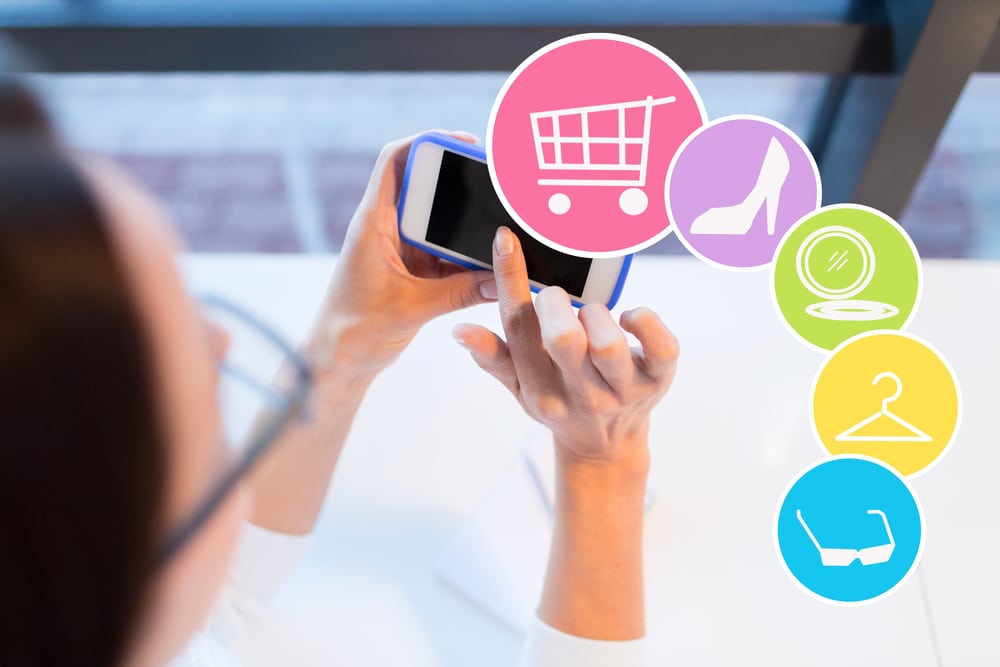Consumers’ shopping behaviors are shifting to mobile apps for retail businesses—and brands need to follow suit. In the first half of 2018, consumers downloaded over 2 billion shopping apps to help them make their everyday purchases. This trend of consumers using mobile apps for shopping is not isolated to online sales, either. They are also using mobile apps to assist them as they traverse the aisles of brick-and-mortar locations.
When online shopping first began, many experts believed it would spell the end of physical retail locations. However, mobile devices have altered these predictions, and instead, are driving consumers to return to the shopping aisle while using mobile devices as digital shopping assistants. With this in mind, mobile apps for retail businesses should support both online and in-store sales to provide consumers with a memorable, loyalty-driving experience.
Tracking the Behavioral Shift to Mobile Apps for Retail Business
It’s possible that no one truly estimated the potential of the mobile shopping industry. This isn’t just because it changed how consumers shopped online. It’s also because mobile use had an unprecedented impact on brick-and-mortar shopping behaviors in several ways.
- It reversed showrooming: Initially, one of the only limitations of online shopping was consumers couldn’t physically interact with products. As a result, they began going to the store to view products, then returning home to purchase them online. This “showrooming” resulted in a loss to brick-and-mortar locations. However, mobile features that allow consumers to browse and purchase from anywhere have inverted this practice. Consumers can place an order via a mobile device to pick it up at the store. They can also use their mobile devices to comparison shop right from the shopping aisle. They’re even using their mobile phones to pay for these items at checkout. The internet now aids in the process of in-store shopping, rather than competing against it.
- It eliminated sales segmentation: At the start of the online shopping trend, retailers and brands often competed against their own online presence. Consumers had to choose between physical locations or online shopping. Mobile shopping developments now allow consumers to shop from anywhere by merging the physical space with the digital one. Mobile now acts as a guide to in-store shopping, rather than just as a sales avenue.
- It reduced in-store frustrations: Brick-and-mortar shopping offers two clear benefits that online shopping can’t; instant delivery and physical product interaction. It was the drawbacks that led consumers to the convenience of online shopping. Those tired of dealing with long lines or overwhelmed sales associates shifted to online shopping to avoid those problems. However, mobile apps allow consumers to order items ahead of time to be picked up later, eliminating lines. Also, if they want to compare prices or get questions answered, their smartphones take the place of a sales associate, providing them with all the information they need to make an informed purchase.
The development of mobile shopping apps shifted consumers’ purchase behavior for the better. It allowed consumers and companies to benefit from the best aspects of both online and brick-and-mortar shopping while also avoiding the potential pitfalls.
Options in Proprietary and Third-Party Apps for Brands and Retailers
 Mobile apps for retail business have grown extensively since the days of bare-boned ordering platforms. These apps cover a range of necessities on the path to purchase, from finding product information to buying it in the store and collecting rewards points. As consumers expect certain features to be available within mobile shopping apps, brands must consider the benefit of working with third-party apps.
Mobile apps for retail business have grown extensively since the days of bare-boned ordering platforms. These apps cover a range of necessities on the path to purchase, from finding product information to buying it in the store and collecting rewards points. As consumers expect certain features to be available within mobile shopping apps, brands must consider the benefit of working with third-party apps.
With a branded proprietary app, brands can reward loyal customers and also share branded marketing materials and notifications with consumers who have opted in. Sure they can control the content on their branded apps and reach those who have opted in, but what about those consumers who aren’t familiar with the brand?
When considering mobile apps for retail business and brand marketing, the best solution is to leverage both proprietary and third-party apps.
Third-party apps offer the ability to reach a wider audience of consumers. These individuals may not be entirely familiar with a brand but are open to trying it out. Third-party apps can also allow brands and retailers to take advantage of innovative mobile features like augmented reality and mobile wallets. They can also work well for in-store customer engagement by incentivizing certain purchase path behaviors. Shopkick leverages this strategy by allowing consumers to scan UPCs to receive kicks (reward points) which can later be redeemed for gift cards. Through this strategy, Shopkick helps brands guide consumers to specific products, incentivize engagement, and increase the purchase potential.
When considering mobile apps for retail business and brand marketing, the best solution is to leverage both proprietary and third-party apps. By combining branded apps with mobile apps, brands can take advantage of the high demand for mobile shopping options. This is where consumers are flocking to make their purchases, so brands with a robust mobile presence will have an edge online and in the shopping aisle.
Shopkick partners use our mobile app to offer consumers a fun, tech-savvy way to gain rewards in the shopping aisle. To use our app as part of your mobile marketing mix, contact us.
Image courtesy of Syda Productions


